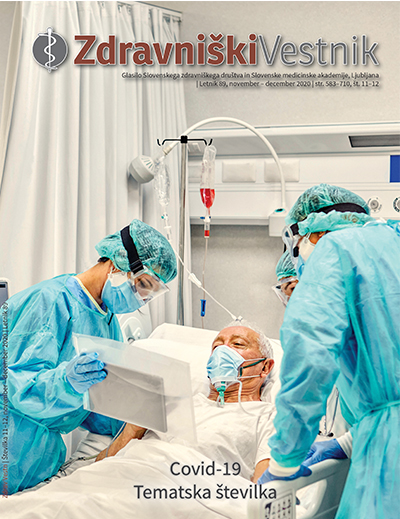COVID-19: a killer with »silent hypoxemia«
DOI:
https://doi.org/10.6016/ZdravVestn.3100Keywords:
covid-19, severe acute respiratory syndrome, silent hypoxemiaAbstract
The most frequent symptoms and signs of SARS-CoV-2 infection are fever, cough, fatigue and weakness, loss of smell and taste and headache. In some covid-19 patients, there is rapidly progressing hypoxemia which is not accompanied by dyspnea or perception of increased work of breathing. It is called “silent hypoxemia” and it can be life-threatening. We present two cases of patients with covid-19 pneumonia, silent hypoxemia, and rapidly progressing respiratory failure. Possible pathophysiological mechanisms are discussed.
Downloads
References
1. Zhu J, Ji P, Pang J, Zhong Z, Li H, He C, et al. Clinical characteristics of 3062 COVID-19 patients: A meta-analysis. J Med Virol. 2020;92(10):1902-14.
DOI: 10.1002/jmv.25884
PMID: 32293716
2. Pan F, Ye T, Sun P, Gui S, Liang B, Li L, et al. Time Course of Lung Changes at Chest CT during Recovery from Coronavirus Disease 2019 (COVID-19). Radiology. 2020;295(3):715-21.
DOI: 10.1148/radiol.2020200370
PMID: 32053470
3. Shi H, Han X, Jiang N, Cao Y, Alwalid O, Gu J, et al. Radiological findings from 81 patients with COVID-19 pneumonia in Wuhan, China: a descriptive study. Lancet Infect Dis. 2020;20(4):425-34.
DOI: 10.1016/S1473-3099(20)30086-4
PMID: 32105637
4. Hong X, Xiong J, Feng Z, Shi Y. Extracorporeal membrane oxygenation (ECMO): does it have a role in the treatment of severe COVID-19? Int J Infect Dis. 2020;94:78-80.
DOI: 10.1016/j.ijid.2020.03.058
PMID: 32251794
5. Parshall MB, Schwartzstein RM, Adams L, Banzett RB, Manning HL, Bourbeau J, et al.; American Thoracic Society Committee on Dyspnea. An official American Thoracic Society statement: update on the mechanisms, assessment, and management of dyspnea. Am J Respir Crit Care Med. 2012;185(4):435-52.
DOI: 10.1164/rccm.201111-2042ST
PMID: 22336677
6. Burki NK, Lee LY. Mechanisms of dyspnea. Chest. 2010;138(5):1196-201.
DOI: 10.1378/chest.10-0534
PMID: 21051395
7. Moosavi SH, Golestanian E, Binks AP, Lansing RW, Brown R, Banzett RB. Hypoxic and hypercapnic drives to breathe generate equivalent levels of air hunger in humans. J Appl Physiol (1985). 2003;94(1):141-54.
DOI: 10.1152/japplphysiol.00594.2002
PMID: 12391041
8. Adams L, Chronos N, Lane R, Guz A. The measurement of breathlessness induced in normal subjects: individual differences. Clin Sci (Lond). 1986;70(2):131-40.
DOI: 10.1042/cs0700131
PMID: 3956105
9. Yuki K, Fujiogi M, Koutsogiannaki S. COVID-19 pathophysiology: A review. Clin Immunol. 2020;215:108427.
DOI: 10.1016/j.clim.2020.108427
PMID: 32325252
10. Weil JV, Byrne-Quinn E, Sodal IE, Friesen WO, Underhill B, Filley GF, et al. Hypoxic ventilatory drive in normal man. J Clin Invest. 1970;49(6):1061-72.
DOI: 10.1172/JCI106322
PMID: 5422012
11. Veit F, Weissmann N. Angiotensin-converting enzyme 2 activation for treatment of pulmonary hypertension. Am J Respir Crit Care Med. 2013;187(6):569-71.
DOI: 10.1164/rccm.201301-0133ED
PMID: 23504361
12. Verdecchia P, Cavallini C, Spanevello A, Angeli F. The pivotal link between ACE2 deficiency and SARS-CoV-2 infection. Eur J Intern Med. 2020;76:14-20.
DOI: 10.1016/j.ejim.2020.04.037
PMID: 32336612
13. Gattinoni L, Coppola S, Cressoni M, Busana M, Rossi S, Chiumello D. COVID-19 Does Not Lead to a “Typical” Acute Respiratory Distress Syndrome. Am J Respir Crit Care Med. 2020;201(10):1299-300.
DOI: 10.1164/rccm.202003-0817LE
PMID: 32228035
14. Lang M, Som A, Mendoza DP, Flores EJ, Reid N, Carey D, et al. Hypoxaemia related to COVID-19: vascular and perfusion abnormalities on dual-energy CT. Lancet Infect Dis. 2020;S1473-3099(20):30367-4.
DOI: 10.1016/S1473-3099(20)30367-4
PMID: 32359410
15. Wang J, Hajizadeh N, Moore EE, McIntyre RC, Moore PK, Veress LA, et al. Tissue plasminogen activator (tPA) treatment for COVID-19 associated acute respiratory distress syndrome (ARDS): A case series. J Thromb Haemost. 2020;18(7):1752-5.
DOI: 10.1111/jth.14828
PMID: 32267998
16. Ottestad W, Søvik S. COVID-19 patients with respiratory failure: what can we learn from aviation medicine? Br J Anaesth. 2020;125(3):e280-1.
DOI: 10.1016/j.bja.2020.04.012
PMID: 32362340
17. Xie J, Covassin N, Fan Z, Singh P, Gao W, Li G, et al. Association Between Hypoxemia and Mortality in Patients With COVID-19. Mayo Clin Proc. 2020;95(6):1138-47.
DOI: 10.1016/j.mayocp.2020.04.006
PMID: 32376101
18. Zheng Z, Peng F, Xu B, Zhao J, Liu H, Peng J, et al. Risk factors of critical & mortal COVID-19 cases: A systematic literature review and meta-analysis. J Infect. 2020;81(2):e16-25.
DOI: 10.1016/j.jinf.2020.04.021
PMID: 32335169
Downloads
Published
Issue
Section
License

The Author transfers to the Publisher (Slovenian Medical Association) all economic copyrights following form Article 22 of the Slovene Copyright and Related Rights Act (ZASP), including the right of reproduction, the right of distribution, the rental right, the right of public performance, the right of public transmission, the right of public communication by means of phonograms and videograms, the right of public presentation, the right of broadcasting, the right of rebroadcasting, the right of secondary broadcasting, the right of communication to the public, the right of transformation, the right of audiovisual adaptation and all other rights of the author according to ZASP.
The aforementioned rights are transferred non-exclusively, for an unlimited number of editions, for the term of the statutory
The Author can make use of his work himself or transfer subjective rights to others only after 3 months from date of first publishing in the journal Zdravniški vestnik/Slovenian Medical Journal.
The Publisher (Slovenian Medical Association) has the right to transfer the rights of acquired parties without explicit consent of the Author.
The Author consents that the Article be published under the Creative Commons BY-NC 4.0 (attribution-non-commercial) or comparable licence.



